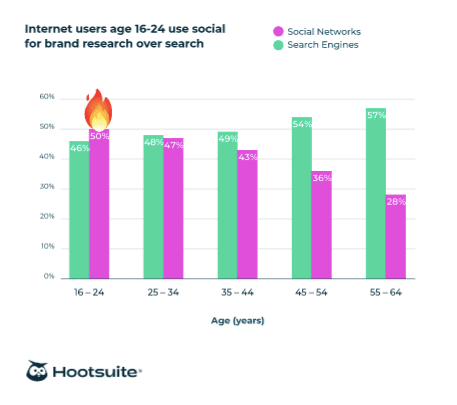Nearly half of internet users seek out brands on social
- To be exact, 49.2% of internet users worldwide use social media to learn about brands and see their content. And it’s not just kids – even in the 55-to-64-year-old age group, 41.3% of women are seeking out brands on social media.
- Social media is also an important vehicle for brand discovery: 27% of Internet users aged 16 to 64 discover new brands through social ads, and 43.3% use social networks as a primary source of information for brand research.
- For younger users, social networks are the preferred source of information for brand research (50%), outanking even search engines (46%).
Source: Hootsuite 2023 Social Trends Report
Social media users play the field
- The average person uses 7.2 social media platforms every month. That gives you the opportunity to reach them through multiple touchpoints. But it’s a better idea to use one or two platforms really well than to spread yourself too thin by trying to be everywhere at once.
Short-form vertical video is critical
- TikTok’s ad reach grew 14.6% from Q4 2021 to Q4 2022, now reaching 945 million adults over age 18. Note that ad reach is an important statistic even if you only plan to use TikTok organically, as it can be used as a general indicator of how many people are using the platform.
- The global audience for ads in Facebook Reels grew by almost 40% from Q3 2022 to Q4.
1. Research your audience
In order for your social media marketing to be successful, you need to understand who you’re trying to reach. This will involve some audience research.
You can start your research by understanding the different demographics of each social platform. We’ve done a lot of the work here for you, comparing the key demographic details you need to know:
- Facebook demographics
- Twitter demographics
- Instagram demographics
- Pinterest demographics
- Snapchat demographics
- LinkedIn demographics
- TikTok demographics
But this is just the starting point. You need to understand your specific audience, so you can get a clear picture of how to tailor your social media content, which platforms to use, and how to develop your brand voice.
As you come to understand who you want to reach, it can be helpful to develop audience personas.
2. Understand social media goals and KPIs
Everything you do on social media should be underpinned by a solid strategy based on realistic social media goals. Each of those goals will be tied to measurable data in the form of key performance indicators (KPIs).
For inspiration on what kinds of goals to set for your social media marketing efforts, look to the advantages of social media outlined at the top of this post. For example, you could aim to:
- Increase brand awareness
- Improve community engagement
- Drive online sales
We’ve got a whole blog post filled with examples of social media marketing goals, if you need some help getting started.
One critical element of goal setting is determining how you will track and measure your success. That’s where KPIs come in.
Fortunately, social media analytics make it quite straightforward to track and report on your social media performance. For details, consult our post on everything you need to know about social media analytics.
3. Plan and schedule your content in advance
Creating effective social content takes planning. Rather than creating your content on the fly, take the time to map out your posts in advance. This allows you to be strategic and consistent in your messaging across platforms.
Creating and scheduling content in batches allows you to make much more effective use of your time. Instead of interrupting your work multiple times per day (or night) to post on social, you can create content in dedicated blocks of your workday, then schedule your posts to go live on the right networks at the right time. A social media marketing dashboard like Hootsuite will help you schedule all of your posts in one place and keep a bird’s eye view of your content strategy at all times.
This advance planning also allows you to bring multiple people into the content creation process, so you can access more skill sets or just have a fresh set of eyes look at your captions before you post.
4. Involve your community
Social media marketing is unlike marketing on any other platform. It’s a two-way street, with communication flowing from the brand to consumers and consumers back to the brand.
So, it’s important to get your community involved in your brand. You could try a social media contest, or use a branded hashtag to collect user-generated content to share on your feed.
Above all, make sure to respond when your followers engage with your content. Answer comments, thank particularly active users, and be sure to stay on top of your DMs.
5. Monitor your competition
Social media is an incredibly effective platform for competitor research. You can see what your competitors are doing in real time, and even listen in on the conversation happening about competitive brands.
Social listening is a great jumping-off point for your competitor research. Using automated tools, you can track mentions of your competitors, even when they’re not tagged. You can see what’s working for them, and what strategies might backfire.
This is extremely valuable information as you develop your own social marketing strategy. You don’t want to copy your competitors, but you can certainly learn from their successes and mistakes. You can also learn about new promotions, products, or company shakeups in real time.
Hootsuite Academy
Hootsuite Academy offers social media training and certification through online courses taught by professionals in the marketing and social media industries. More than half a million people have taken courses through Hootsuite Academy, and more than 1,000 universities are enrolled in the programs.
Once you pass the exam for a Hootsuite Academy program, you receive a digital certification you can display on your LInkedIn profile to highlight your expertise.
Native training and certifications from the social platforms
The social platforms want brands to find success with their tools. To that end, many of them have created their own social media marketing courses along with training and certification resources to help businesses and social media marketers learn how to use all of their features.
Udacity Nanodegree in digital marketing
This three-month online program takes you from the fundamentals through to immersive projects that help you understand how digital marketing really works. You get access to a mentor and career support.
Insider Intelligence
Insider Intelligence is known for its forecasts and analysis. Full access requires a subscription, but you can gain plenty of insight from the freely accessible articles and podcasts.
In particular, their daily Behind The Numbers podcast is packed with digital marketing insights, and is available wherever you get your podcasts.
The #AskGaryVee Podcast
Gary Veynerchuk accepts questions on Twitter using the #AskGaryVee branded hashtag, then answers some of the most pressing in every episode.
If you’re an audio learner, there are plenty of podcasts to help you develop your social marketing skills. We’ve compiled a list of some of our faves.
#TwitterSmarter
Whether you join in the weekly #TwitterSmarter Twitter chat or listen to the podcast, you’ll gain important and up-to-the-minute insights on how best to incorporate Twitter into your social media marketing strategy. Host Madalyn Sklar is a top expert in the Twitter space, and regularly participating in #TwitterSmarter will help you, well, do Twitter smarter.
Social Media Marketing: The Next Generation of Business Engagement
This textbook by social media strategist Dave Evans, founder of Digital Voodoo, offers practical tips on how to establish a social media strategy and increase engagement with your social followers.
This book also gets into the details of how to connect social media throughout your organization. Rather than focusing only on the social media team, it explains how to use social media for customer service, employee engagement, and even product development.
Google Scholar
If you want to dive into the latest academic research on social media marketing, Google Scholar is the place to start your search.
Some interesting reads include:
- Friedland, The Next Step in Social Media Marketing?
- Saravanakumar & SuganthaLakshmi, Social Media Marketing
- Mason, Narcum & Mason, Social media marketing gains importance after Covid-19
So, is social media marketing right for your brand? Let’s look at a few of the arguments for and against.
Pros of social media marketing
- Connect with your audience where they already spend time online
- Low barriers to entry – it’s free to create a business account on all major social platforms
- Create brand loyalty
- Expand your audience
- Get audience feedback that can apply to all areas of your business
- Learn about your audience through social analytics
- Refine your strategy with real-time testing
Cons of social media marketing
- Requires some time to do it right
- Initial follower growth can be a challenge
- Potential security risks if not managed correctly
For most businesses, the advantages of social media marketing far outweigh the risks. If your audience is already on social media, they expect to find you there. Without an active social media presence, you’re missing out on an important way to grow your brand.
Fortunately, it’s easy to get started. You don’t need to do everything all at once. The first step is building your social media marketing strategy.
Social media marketing FAQ
What is social media marketing?
Social media marketing is the practice of using social media platforms to promote a brand and connect with customers.
The intended outcomes can range from building brand awareness to increasing sales.
How do beginners start social media marketing?
If you’re a complete beginner, start with research. Identify a few competitors, find their social accounts, and take note of what seems to be working for them. Then, create accounts on the social platforms that best fit your audience demographic and start creating your own content. Post consistently and closely watch your performance stats to get an understanding of which strategies are the most effective — and do more of what works.



